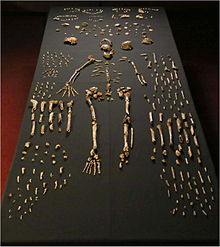



Homo naledi is an extinct species of hominin, which anthropologists first described in September 2015 and have assigned to the genus Homo. In 2013, fossil skeletons were found in the Gauteng province of South Africa, in a chamber of the Rising Star Cave system, part of the Cradle of Humankind World Heritage Site about 50 km (31 mi) northwest of Johannesburg. Although archaic features of its skeleton resembled fossil specimens roughly two million years old, in 2017 the fossils were dated close to 250,000 years ago, and thus contemporary with the first appearance of larger-brained anatomically modern humans. The research team therefore thinks that H. naledi is not a direct ancestor of modern humans, but probably an offshoot within the genus Homo.
The species is characterised by a body mass and stature similar to small-bodied human populations, a smaller endocranial volume similar to Australopithecus, and a skull shape similar to early Homo species. The skeletal anatomy presents ancestral features known from australopithecines with more recent features associated with later hominins. As of 10 September 2015, fossils of at least fifteen individuals, amounting to more than 1550 specimens, have been excavated from the cave. Abundant fossil remains are still within the chamber. Newer findings (remains of at least three individuals: two adults and a child) in a second chamber, known as Lesedi ("light" in the Sotho-Tswana languages), were reported by John Hawks et al. (2017). In May 2018, anthropologists provided evidence that the brain of H. naledi was small, but nonetheless complex, sharing structural similarities with the modern human brain.
The fossils were discovered by recreational cavers Rick Hunter and Steven Tucker in 2013 in the almost inaccessible Dinaledi Chamber ("chamber of stars" in the Sotho-Tswana language). Homo naledi was formally described in September 2015 by a 47-member international team of authors led by South African paleoanthropologist Lee Berger of the University of the Witwatersrand, who proposed that the bones represent a new Homo species. Other experts contend more analyses are needed to support this classification. There are some indications that the hominin bodies may have been deliberately placed in the cave near the time of their death.

A sample of the 1,550 skeletal pieces recovered
